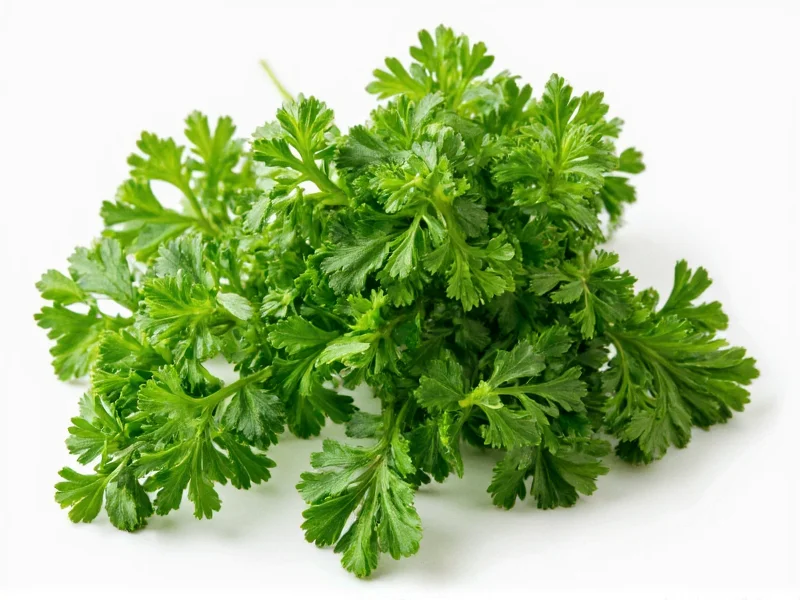Understanding the proper conversion between fresh and dried parsley is essential for achieving balanced flavors in your cooking. While both forms come from the same herb, their flavor intensity, moisture content, and culinary applications differ significantly. Getting the substitution wrong can lead to bland or overpowering dishes, wasting ingredients and compromising your culinary results.
Why Fresh and Dried Parsley Aren't Interchangeable
Fresh parsley contains approximately 85-90% water, which evaporates during the drying process. This concentration effect means dried parsley delivers more intense flavor in a smaller volume. The drying process also alters certain volatile compounds, creating subtle flavor differences between fresh and dried varieties.
Fresh parsley offers bright, grassy notes with a slight peppery finish, making it ideal for finishing dishes or using in raw preparations. Dried parsley develops earthier, more muted herbal characteristics that blend well into cooked dishes but lack the vibrant freshness of its raw counterpart.
Precise Fresh Parsley to Dried Conversion Guide
While the basic 3:1 ratio serves as a reliable starting point, optimal substitution depends on your specific recipe and desired flavor profile. Consider these nuanced conversion guidelines for different culinary applications:
| Measurement | Fresh Parsley | Dried Parsley Equivalent | Best For |
|---|---|---|---|
| Standard Ratio | 3 tablespoons | 1 tablespoon | Most cooked dishes |
| Delicate Dishes | 3 tablespoons | 2 teaspoons | Fish, eggs, light sauces |
| Robust Dishes | 3 tablespoons | 1 tablespoon + 1/4 tsp | Stews, braises, hearty soups |
| Finishing Touch | 2 tablespoons | 1/2 teaspoon | Added at the end of cooking |
When to Choose Fresh Over Dried (and Vice Versa)
Chefs and home cooks should consider these factors when deciding between fresh and dried parsley for recipe substitution:
Use Fresh Parsley When:
- Creating garnishes or finishing dishes (the vibrant color enhances presentation)
- Preparing raw applications like salads, chimichurri, or tabbouleh
- Seeking bright, grassy flavor notes in light dishes
- Working with Mediterranean or Middle Eastern cuisine
Use Dried Parsley When:
- Preparing long-cooked dishes like stews, soups, or braises
- Creating spice blends or dry rubs
- When fresh herbs aren't available or practical
- Working with recipes that benefit from earthier herbal notes
Maximizing Flavor in Parsley Substitutions
To achieve the best results when substituting dried parsley for fresh, follow these professional techniques:
Rehydration Method for Better Flavor Integration
For dishes with shorter cooking times, rehydrate dried parsley before use. Combine 1 teaspoon dried parsley with 1 tablespoon warm water or broth and let sit for 5-10 minutes. This restores some moisture content and helps the herb integrate more naturally into your dish.
Timing Matters in the Cooking Process
Add dried parsley early in the cooking process to allow its flavors to fully develop and distribute. Unlike fresh parsley, which loses vibrancy when overcooked, dried parsley needs time to reconstitute and release its flavor compounds. For most recipes, incorporate dried parsley during the first 15-20 minutes of cooking.
Flavor Balancing Techniques
Dried parsley lacks the bright acidity of fresh varieties. When substituting, consider adding a small amount of acid (like lemon juice or vinegar) to balance the earthier flavor profile. Start with 1/8 teaspoon acid per tablespoon of dried parsley and adjust to taste.
Storage Considerations for Optimal Freshness
Proper storage significantly impacts the quality and shelf life of both fresh and dried parsley, affecting your conversion accuracy over time:
Fresh Parsley Storage
Store fresh parsley like cut flowers: trim stems, place in a glass with 1-2 inches of water, cover loosely with a plastic bag, and refrigerate. Change water every 2-3 days. Properly stored, fresh parsley maintains peak quality for 1-2 weeks. After this period, you may need to increase quantities slightly as flavor diminishes.
Dried Parsley Storage
Keep dried parsley in an airtight container away from light, heat, and moisture. Properly stored, dried parsley maintains optimal flavor for 1-2 years. After 6 months, flavor intensity gradually decreases, meaning you might need to use slightly more than standard conversion ratios for older dried herbs.
Common Substitution Mistakes to Avoid
Even experienced cooks make these errors when converting between fresh and dried parsley:
- Using equal measurements - Never substitute 1:1; dried herbs are always more concentrated
- Adding dried parsley too late - It needs time to reconstitute and release flavors
- Not adjusting for recipe moisture content - In very dry recipes, you may need slightly less dried parsley
- Using old dried herbs - Stale dried parsley has lost significant flavor potency
- Ignoring flavor profile differences - Dried parsley won't provide the same bright finish as fresh
Special Considerations for Specific Cuisines
Certain culinary traditions have specific expectations for parsley usage that affect substitution ratios:
Mediterranean dishes often rely on fresh parsley's vibrant flavor, making direct substitution with dried parsley less ideal. If you must substitute, use the delicate dishes ratio (3:2) and add a squeeze of lemon to mimic freshness.
Eastern European cuisines frequently use dried parsley in traditional recipes, so conversions follow standard ratios more closely. These dishes were often developed with dried herbs in mind due to historical preservation needs.
For French cuisine, where parsley appears in both fresh and dried applications, follow the specific recipe's intended form when possible. If substituting, use the standard ratio but consider the dish's overall herb balance.











 浙公网安备
33010002000092号
浙公网安备
33010002000092号 浙B2-20120091-4
浙B2-20120091-4